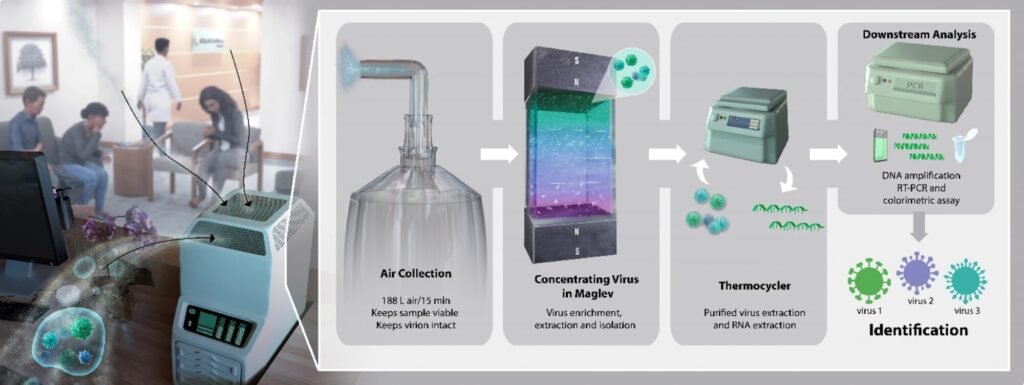MSU and the University of British Columbia have developed a system that uses magnetic levitation to help capture, clean and detect viruses, including the coronavirus, the invention helps detect airborne pathogens in time
Researchers from Michigan State University and the University of British Columbia have developed a system that can detect infectious diseases quickly and cheaply using the same technology that allows high-speed trains.
The team showed that a technique known as magnetic levitation could be used to collect and concentrate airborne bacteria to help prevent future outbreaks of respiratory disease. The researchers published their work in the journal ACS Nano.

Morteza Mahmoudi, an assistant professor in the Department of Radiology and Precision Health Program at MSU, said, “Having time management and predicting disease is very important.” “What we’ve developed is a method that can help us and others get more information about the different types of bacteria in the air we breathe.”
Sepideh Pakpour, assistant professor of engineering who led the research team at the UBC Okanagan campus, said, “It can help identify the environment that is affected before an epidemic occurs.”
In addition to serving as an early warning system, the group’s new system can also help health workers and infectious disease patients to be smart and detect exposure to viruses in public places.
Pakpour and Mahmoudi started this project by applying magnetic levitation, or maglev, to respiratory viruses in 2018 with support from the Walsh Foundation and the New Frontiers in Research Fund.
Almost half of all respiratory infections are caused by bacteria that people breathe indoors, the researchers wrote in their report.
But when the coronavirus pandemic started and they knew it was caused by an infectious virus, they knew they had to act. The team used a defective version of the coronavirus responsible for COVID-19 in their proof-of-concept report, as well as the H1N1 flu and a virus that infects bacteria known as bacteriophage MS2.
The system first collects an air sample, then submerges the sample in water where a maglev separates the bacteria from other particles. The isolated and purified viral content is submitted to other standard analytical methods for identification within minutes. The method is so simple that non-professionals can use it in various settings, such as hospitals and airports, researchers said.
The group is taking the first step in commercializing its technology as it works to improve it. Although the descending method can identify the viruses in the sample, one of the team’s future goals is to modify the maglev step to distinguish between the different viruses itself.
The researchers are also working to increase the understanding of their process and detect viruses in the air in small concentrations. Still, the team is excited about what they’ve been able to accomplish in their first project, and what they can inspire other researchers to do.
“The use of maglev for disease diagnosis and disinfection is new, and it can open up applications in many different fields,” Mahmoudi said. “This opens important new avenues in research biochemistry.”
A successful test flight for viral levitation
Magnetic magnets, as the name suggests, use magnets to resist the pull of gravity. Maglev trains floating on their tracks, unimpeded by this contact friction, can reach more than 200 kilometers per hour. Although maglev trains have been around for decades, the use of magnetic levitation in biology is relatively recent.
For example, it was only in the last decade that Stanford researchers demonstrated that living cells can use magnets in water mixtures or solutions. They used the technique to show that different types of cells – yeast, bacteria, healthy human cells and cancer cells – could be separated by their density.
Recently, Pakpour and Mahmoudi collaborated to show that maglev can be applied to blood plasma proteins to look for signs of opioid use in multiple sclerosis. This led them to believe that maglev should also work on viruses.
“If you look at the structure of viruses, they’re mostly proteins, and we know we can make proteins,” Pakpour said. “So I know it’s supposed to work, but I’m still surprised when it works.”
“It was very difficult, especially in the beginning,” Mahmoudi said. “Traditional maglevs can’t collect submicron viruses, but we made some changes and were able to adjust the system.”
One of the challenges, for example, is that the fluids used in conventional maglevs can damage or destroy bacteria. The team had to find a new solution that has a magnet that is desirable and compatible with their targets.
“As with most books, what you see is only positive results,” Mahmoudi said. “What you don’t see is how much effort it takes to get them.”
“The students spent months and months working on everything,” Pakpour said. These challenges are exacerbated by pandemics, but the outbreak of COVID-19 has shown the team how important their work is and how strong their team is.
“There are a lot of obstacles, even getting samples,” Pakpour said. “But we will go forward. But, if we win this battle, I think we can win again.
Source: Michigan State University



































